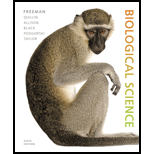
Concept explainers
What is a sieve-tube element?
a. the sugar-conducting cell found in phloem
b. the widened, perforation-containing, water-conducting cell found only in
c. the nutrient- and water-absorbing cell found in root hairs
d. the nucleated and organelle-rich support cell found in phloem
Introduction:
The plants consist of two important tissues, namely, phloem and xylem. Phloem is responsible for the transfer of organic molecules across different cells in the plants. Sieve-tube cells are the specialized cells that are present in the phloem tissue for the transport of carbohydrates.
Answer to Problem 1TYK
Correct answer:
The sieve-tube cells or the sieve-tube elements are the dead, elongated cells found in the phloem of the angiosperms. These elements carry out the transfer of sugar in the plants.
Explanation of Solution
Explanation/Justification for the correct answer:
Option (a) is given as the cell that is responsible for the conduction of sugars. The sieve-tube elements are the specialized cells involved in the conduction of the sugars in the plants. Carbohydrate (starch) is one such form of sugar. On maturity, they are considered as dead cells due to lack of nucleus. These cells are present in the phloem of the angiosperms. Hence, Option (a) is correct.
Explanation for incorrect answer:
Option (b) is given as the widened, perforation-containing, water-conducting cell found only in angiosperms. The perforation-containing, widened cells that carry out transport of water are known as xylem. So, it is a wrong answer.
Option (c) is given as cells that are found in the root hairs and are responsible for the absorption of water and nutrients. The roots hairs are also known as trichoblasts. The trichoblast is formed from the epidermis layer of the root of the plant. So, it is a wrong answer.
Option (d) is given as the nucleated and organelle-rich cells found in phloem. The nucleated and organelle-rich support cells in the phloem are also known as companion cells. The companion cells are those that transport the sugar to the sieve-tube elements in the leaves from the mesophyll. So, it is a wrong answer.
Hence, options (b), (c), and (d) are incorrect.
Thus, sieve–tube cells represent the class of cells that are specialized for the transportation of sugar in the plants and are found in the phloem.
Want to see more full solutions like this?
Chapter 34 Solutions
Biological Science (6th Edition)
- Molecular Biology Question A gene that codes for a protein was removed from a eukaryotic cell and inserted into a prokaryotic cell. Although the gene was successfully transcribed and translated, it produced a different protein than it produced in the eukaryotic cell. What is the most likely explanation?arrow_forwardMolecular Biology LIST three characteristics of origins of replicationarrow_forwardMolecular Biology Question Please help. Thank you For E coli DNA polymerase III, give the structure and function of the b-clamp sub-complex. Describe how the structure of this sub-complex is important for it’s function.arrow_forward
- Molecular Biology LIST three characteristics of DNA Polymerasesarrow_forwardMolecular Biology RNA polymerase core enzyme structure contains what subunits? To form holo enzyme, sigma factor is added to core. What is the name of the structure formed? Give the detailed structure of sigma factor and the function of eachdomain. Please help. Thank youarrow_forwardMolecular Biology You have a single bacterial cell whose DNA is labelled with radioactiveC14. After 5 rounds of cell division, how may cells will contain radioactive DNA? Please help. Thank youarrow_forward
- 1. Explain the structure and properties of atoms and chemical bonds (especially how they relate to DNA and proteins). Also add some pictures.arrow_forward1. In the Sentinel Cell DNA integrity is preserved through nanoscopic helicase-coordinated repair, while lipids in the membrane are fortified to resist environmental mutagens. also provide pictures for this question.arrow_forwardExplain the structure and properties of atoms and chemical bonds (especially how they relate to DNA and proteins). Also add some pictures.arrow_forward
- In the Sentinel Cell DNA integrity is preserved through nanoscopic helicase-coordinated repair, while lipids in the membrane are fortified to resist environmental mutagens. also provide pictures for this question.arrow_forward1. Explain how genetic information is stored, copied, transferred, and expressed. Also add some pictures for this question.arrow_forward!. Describe biological macromolecules (DNA, RNA, proteins, lipids, etc.) and how they function in the cell. also provide some images for this question.arrow_forward
 Biology (MindTap Course List)BiologyISBN:9781337392938Author:Eldra Solomon, Charles Martin, Diana W. Martin, Linda R. BergPublisher:Cengage Learning
Biology (MindTap Course List)BiologyISBN:9781337392938Author:Eldra Solomon, Charles Martin, Diana W. Martin, Linda R. BergPublisher:Cengage Learning
 Concepts of BiologyBiologyISBN:9781938168116Author:Samantha Fowler, Rebecca Roush, James WisePublisher:OpenStax College
Concepts of BiologyBiologyISBN:9781938168116Author:Samantha Fowler, Rebecca Roush, James WisePublisher:OpenStax College Biology 2eBiologyISBN:9781947172517Author:Matthew Douglas, Jung Choi, Mary Ann ClarkPublisher:OpenStax
Biology 2eBiologyISBN:9781947172517Author:Matthew Douglas, Jung Choi, Mary Ann ClarkPublisher:OpenStax Biology Today and Tomorrow without Physiology (Mi...BiologyISBN:9781305117396Author:Cecie Starr, Christine Evers, Lisa StarrPublisher:Cengage Learning
Biology Today and Tomorrow without Physiology (Mi...BiologyISBN:9781305117396Author:Cecie Starr, Christine Evers, Lisa StarrPublisher:Cengage Learning Biology: The Dynamic Science (MindTap Course List)BiologyISBN:9781305389892Author:Peter J. Russell, Paul E. Hertz, Beverly McMillanPublisher:Cengage Learning
Biology: The Dynamic Science (MindTap Course List)BiologyISBN:9781305389892Author:Peter J. Russell, Paul E. Hertz, Beverly McMillanPublisher:Cengage Learning





